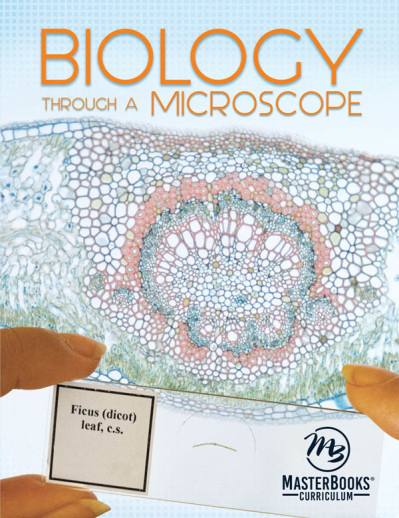We use cookies to make your experience better. To comply with the new e-Privacy directive, we need to ask for your consent to set the cookies. Learn more.
Biology Through a Microscope (Lab Book)
View the mystery and remarkable detail found in God's microscopic world through the detailed, full-color images in this supplemental resource. Beginning with a brief history of microscopes, students will learn detailed information and practical tips for using a modern microscope in the classroom, view examples of stained and unstained slide samples, study brightfield, darkfield and phase contrast microscopy, and view detailed full color images. A sampling of included slide images include fibers, minerals, animal muscle, skin, hair, blood, flatworm, cheek cells, paramecium, bacteria, human blood, mosquito, fruit fly, amoeba, yeast, mold, algae, and much more. To aide students and teachers, many of the slide images are labeled for easier identification of microscopic structures. This may be exceptionally beneficial for a student who struggles to view microscopic slides due to vision issues or other learning challenges. While an excellent supplement to any biology curriculum, it is also a companion book to Master Books Biology (item # 049117). If using this book alongside the Master Books Biology course, you would not need a microscope to fulfill the microscopic lab requirements. 96 pgs, pb. ~ Deanne
Providing an overview of God's world through a microscope, this book gives a brief history of microscopes before diving into seeing the world through one. Starting with their simple origins in the 13th century as magnifying glasses and exploring some of the many modern varieties of imaging, we explore how they are used and some of what may be seen through one now.
- Filled with full-color microscopic images of varied animals, insects, plants and fungi, and microorganisms, as well as detailed information for using the modern microscope in the classroom.
- Discusses examples of stained and unstained slide samples, brightfield, darkfield, and phase contrast microscopy.
- Includes practical tips about the use of the microscope and labels many of the slide images for easier identification of microscopic structures.
Though this is an independent text that can be used with any biology study, it also serves as a companion book in the Master's Class Biology: The Study of Life From a Christian Worldview high school course available from Master Books®. Those who purchase this book would not have to purchase a microscope in order to fulfill the requirements.
Table of Contents- General Microscope
- Animals
- General Biology: Animal Skin / Muscle
- Dog
- Flatworm
- Frog
- Hydra
- Mouse
- Pig
- Rabbit
- Roundworm
- Bird: Feather Structures
- Insects
- Bee
- Butterfly
- Fruit Fly
- Housefly
- Mantis
- Mosquito
- Silkworm
- Plants & Fungi
- General Biology: Plant Structures
- Algae
- Bean
- Buttercup
- Cotton
- Fern
- Fungus
- Grass
- Lily
- Liverwort
- Moss
- Pine
- Squash
- Microorganisms
- Amoeba
- Bacteria
- Egulena
- Paramecium
- Glossary
- Index
Strong enough to be college prep, this high school course takes an average of 5 hours a week. Everything you need (except lab supplies) can be found in the Student Text and Teacher Guide. Dr. Dennis Englin, the author of Master Books Chemistry , makes this Christian worldview Biology course understandable, yet comprehensive, beginning with the basics. Students will first learn about water, then carbohydrates and lipids, proteins and nucleic acids. Then building on this knowledge, students learn about cells, cell membranes and nucleus, movement through cell membranes, cell organelles, and cell division. After learning about the cellular and molecular level of life, students are now ready to go bigger with a wide variety of topics from ecosystems to human origins. With 28 total chapters, this is a one-year, one full credit high school course.
Student Text pages are visually appealing and not overcrowded. Colorful pictures, photos, and illustrations enhance the learning and hold interest. I love the logical course layout. Dr. Englin begins with an explanation of the chemical principles of biology. Understanding the basics of chemistry will help students better understand the foundation of living things, since all things are made of atoms. Every chapter begins by listing objectives. Chapters are divided into bite-size chunks of information with vocabulary words highlighted. Bible verses are also found throughout the text, using the NKJV. Chapters include labs with lists of required materials, explanation, and step-by-step procedures There are microscope and dissection labs. Lab materials may not be readily available but can be ordered from a science supplier. The Lab materials list is found in the Teacher Guide, but you can also call us and we can send the list to you before purchasing the course.
The Teacher Guide is useful for implementing this course. It includes a course description;a page of teacher instructions for the course labs; quizzes; and exams; lab supply list; sample lab report; grading sheet and a daily schedule for both semesters (18 weeks per semester, 36 total weeks); answer keys for lab reports/worksheets/quizzes/exams; and student lab pages; worksheets; quizzes; and exams that are reproducible for family use. The top of each student worksheet page is labeled with the topic, the day number, the lesson number, whether it's a worksheet or lab page, and a place for the student name. Worksheets are fill-in-the-blank questions based on the lesson's reading. For each lab there is a sheet of lab instructions and a place to take notes and a lab report page. Quizzes are matching and/or multiple choice, and the exams are all matching questions (8 exams total). Master Books makes biology homeschool and parent friendly!
| Product Format: | Paperback |
|---|---|
| Brand: | Master Book Publishers |
| Grades: | 9-12 |
| ISBN: | 9781683441915 |
| Length in Inches: | 10.875 |
| Width in Inches: | 8.375 |
| Height in Inches: | 0.25 |
| Weight in Pounds: | 0.6 |

